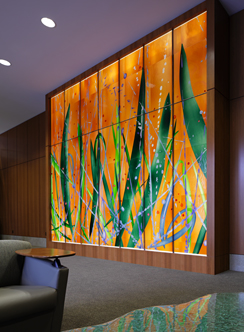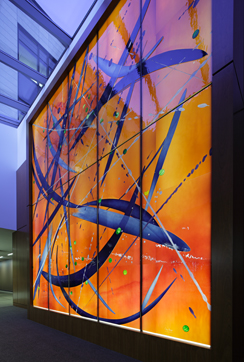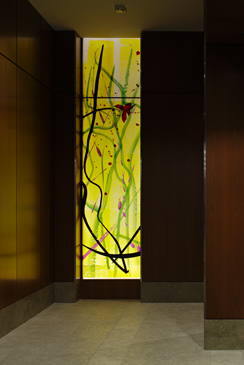Secret Garden, Stellar Wind & For Laurel

Guy Kemper, a painter who creates distinctive spaces using glass, color, and light, created three beautiful pieces for 1500 Jefferson. He works closely with master craftspeople to translate his paintings into blown glass, distinguishing his art from mere glass painting or stained glass.
Secret Garden is a bug’s-eye view of one’s lawn. The blades of grass are thirteen feet tall. There are dew splatters, spider webs and small flowers, making a dense, three-dimensional fabric. The grass is shades of green and blue, the richly textured background is peach, the splatters of dew are white and soft grey-blue and the flowers are red and pink.
This is an arresting work that gives a warm welcome to those entering the building.
Stellar Wind is a companion work to Secret Garden. It is directly above Secret Garden on the mezzanine level.
Whereas Secret Garden is very earthbound, Stellar Wind is more celestial. It has streaks of dark and grey violet-blues that are suggestive of comets, floating feathers, or overhanging trees. There is a similar peach background with splatters as in Secret Garden directly below. Small, shaded and textured green dots are scattered across the surface to add contrast and visual interest. The chaotic foreground is in tension with the peaceful, sunset tones of the background.
For Laurel recalls fresh cut flowers and the mood of springtime. The yellow background suggests early spring light, the chartreuse tendrils speak of new growth, the black lines are the old branches of winter, red and violet splashes give the feeling of spring bursting forth.
 The building’s Property Management company has a prominent place in their buildings for fresh cut flowers. For Laurel intends to replace that reality with the feeling of fresh cut flowers in glass. It is a happy tangle of color at the end of the long hallway off the entrance lobby.
The building’s Property Management company has a prominent place in their buildings for fresh cut flowers. For Laurel intends to replace that reality with the feeling of fresh cut flowers in glass. It is a happy tangle of color at the end of the long hallway off the entrance lobby.
For Laurel was named after the artist's daughter Laurel, his most beautiful creation. The two of them were watercolor painting and chatting together when Kemper painted the work.
These windows were made from blown glass that is laminated with a two-part silicone in several layers. The base glass is 10mm tempered that has been painted with vitreous enamels and fired. There is a bottom layer of blown glass laminated as the “canvas” to this 10mm clear glass. In the two larger installations, there is an aurora double flash glass made with gold to get the pink tone. The yellow window has a selenium double flash that has been etched with acid to reveal brushstrokes.
The base layer of the blown glass has been sandblasted, enameled, and other pieces of etched blown glass have been laminated on top of it. These pieces have also been sandblasted and enameled and had more pieces of blown glass laminated to them. In all, there are six surfaces, or layers, of treatment in the two larger works.
These windows were extremely difficult to make and are the most technically complicated work the artist has done. He considers them a crowning achievement in his catalog.
Though Kemper's aesthetic is contemporary, his process is more or less ancient. It involves blowing large glass bottles with two or three layers of color, cutting off the tops and bottoms, then reheating, opening and flattening them into sheets of glass.
Using an enlarged painting as a guide,  asphaltum was hand painted on the glass as a resist, then strong acid was hand brushed to dissolve away some of the color on the glass surface. This was done several times, and the design began to emerge from the glass in a three-dimensional way.
asphaltum was hand painted on the glass as a resist, then strong acid was hand brushed to dissolve away some of the color on the glass surface. This was done several times, and the design began to emerge from the glass in a three-dimensional way.
More masking was done and the glass was sandblasted and/or vitreous enamels were airbrushed onto the glass and fired in a kiln in several more steps. The pieces were then ground to perfectly abut and laminated onto a base of clear safety glass to make an uninterrupted canvas that is nearly indestructible.
It is a dangerous and labor-intensive process, all done by hand. Only a few craftspeople are left in the world with the expertise to do it.
Kemper chose to do it this way instead of opting for more modern techniques because the refractive properties of mouth-blown glass are unparalleled. It is the most beautiful, sensuous, and durable material available and lasts a minimum of 100 years with minimal maintenance.
The driving force is always beauty before profit and to be timeless, not trendy.
The glass is blown at Lamberts Glassworks in eastern Germany on the Czech border. Lamberts is the last place on earth with the expertise to blow glass in this manner. The raw material is then shipped to Derix Glasstudios, in Taunusstein, near Frankfurt. Here the glass was transformed into the artist's designs using the above-described techniques by Rahmi Schulz, one of the best glass painters in the world.
Active in the corporate, liturgical and public art fields, Kemper's designs are inspired by their particular setting and the surrounding community. Celebrated for their strength and emotional expressiveness, his internationally recognized projects have won several prestigious design awards.